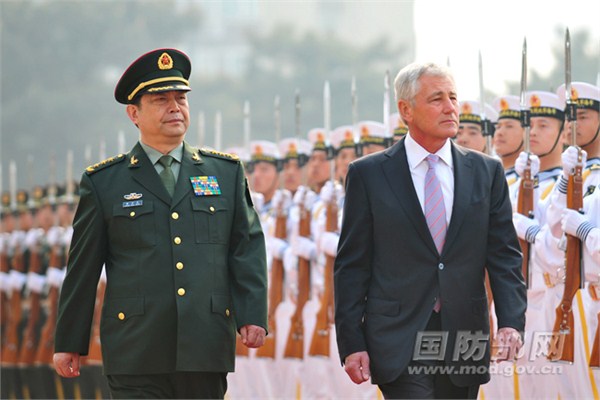
Chinese Perceptions of the “Third Offset Strategy”
Publication: China Brief Volume: 16 Issue: 15
By:

China is deeply committed to a series of military reforms involving reorganization, more realistic training, and advanced weapons—all interconnected by information technology and with the various services and branches working jointly. It set itself two milestones—2020 and 2049. The first of these is to complete military mechanization and full informatization. However, this goal is predicated on achieving a level of technology to deal with the threat posed by high-tech, precision warfare demonstrated by the United States during the first Gulf War in 1991. However, since 2014, U.S. Defense policy-makers, beginning with then-Secretary of Defense Chuck Hagel have committed to pushing the United States military advantages to the next level to respond to emerging conventional-military power parity, the “Third Offset” (OSD, November 15, 2014). Chinese academics and military practitioners are closely watching the “Third Offset” and considering how to recalibrate China’s own modernization plans in response.
The “Third Offset” (trans. “第三个对消战略” or “第三次抵消战略”) appears regularly in Chinese publications, including coverage by the People’s Daily, and security-focused media such as People’s Liberation Army Daily. [1] One article written by Professors at the Air Force Engineering College and Command Academy, Wang Peng (王鹏) Shao Dan (邵丹) took stock after Secretary Hagels’ 2014 speech, noting that the strategy represented an expansion of certain preexisting elements of current strategy toward China (China Defense Daily, November 15, 2014). Wang and Shao also noted that such a strategy would require extensive support within the U.S. Government due to its budgetary requirements, and given the ease with which technology is proliferated, maintaining an edge would also pose difficulties.
Ye Jianjun (叶建军), a professor at the PLA academy of international relations, writing in the Contemporary International Relations, conceptualizes the “Defense Innovation Initiative” as part of “Cold War thinking”. [2] Ye further describes the concept as disruptive and harmful to positive development of international relations.
Such attitudes should perhaps not be surprising, because China is in many ways still completing its own transition to “second offset” technologies, such as building its own domain-awareness capabilities, global positioning satellite constellation (Beidou) and stealth aircraft. The PLA Air Force’s inventory of aircraft is still dominated by older aircraft such as the 3rd-Generation J-8. Newer designs, such as the J-20 stealth bomber, for example, only recently reached “Low Rate Initial Production”, which represents an important, though early, milestone (Sina, July 17).
Moreover, it is important to note that Chinese strategy is not purely-mirror imaging, and frequently makes use of technologies meant to undercut what it perceives as major U.S. strengths. These include the frequently discussed “anti-access” and “assassins’ mace” (反介入; 杀手锏) technologies (though these terms are increasingly out of favor with U.S. officials) which have been a major focus of China’s modernization efforts, including anti-ship ballistic missiles, cruise missiles and advanced air defenses (Twitter, October 3; China Brief, March 28).
However, China has already invested in its own high tech next generation technologies from quantum computing railguns to laser systems, likely in a bid to not only further speed its progress in achieving full capability in Second Offset technologies, but also further pushing it toward further innovations. The Chinese government sees this technological competition as absolutely requiring greater integration of civilian and military technologies to gain a decisive edge (People’s Daily, May 31, 2015).
Chen Liling (陈利玲), Zhao Shuang (赵霜), Wang Liping (汪立萍), are researchers at China Aerospace Science Industry Corporation’s No. 8511 Research Institute in Nanjing. Writing in Aerospace Electronic Warfare (航天电子对抗), they describe the “core” of the “Third offset” as “built on the superiority of precision-guided weapons, which is in turn based on electronic warfare capability.” [3] They note that the experience of the Ukrainian military—whose GPS systems have been regularly jammed by their Russian opponents have further refocused U.S. attention on this electronic warfare component and pushed the U.S. to look toward making systems more intelligent (智能化) to overcome weakness in the electronic sphere. Though in a somewhat different form, unmanned systems are also a priority and would have a higher degree of autonomy, though still tethered to human control. As previously noted in China Brief, China itself is attempting to build the foundation for its own drone capability, and is exporting drones abroad to further fund development (China Brief, May 11).
Appropriately, the Chinese civilian and military establishment are making major investments in Artificial Intelligence (AI; 人工智能), in several cases through cooperation with Western companies (SCMP, April 16). Particularly in the wake of the Snowden revelations, China began producing its own software and hardware, which is seen as reducing a major source of potential vulnerabilities (see: China Brief, “China’s Server Sinification” Parts One & Two).
While this initial overview demonstrates that Chinese defense policy makers are clearly aware of and reacting to the Third Offset, a more thorough investigation of authoritative publications is needed. Moreover, it will be interesting to examine how China’s evolving military strategy will change to cope with both the publicly revealed details of the third-offset, and, like stealth before it, the non-public components when revealed.
Notes:
- A standard text on the development of “A2/AD” systems in the wake of U.S. “second offset” technologies remains Andrew Erickson, “Chinese Anti-Ship Ballistic Missile Development: Drivers, Trajectories and Strategic Implications,” The Jamestown Foundation, 2013. https://jamestown.org/product/chinese-anti-ship-ballistic-missile-development-drivers-trajectories-and-strategic-implications/
- Ye Jianjun (叶建军), “Review: U.S. Military’s ‘National Defense Innovation Initiative,’” (“美军’国防创新行动’评析”) Contemporary International Relations [现代国际关系], 2015, No. 1 pp. 35–40. Note that Contemporary International Relations is the journal of the Chinese Institute for Contemporary International Relations, (CICIR), which is part of China’s intelligence service, the Ministry of State Security (MSS). Regarding “Cold War Mentality” see also “Beijing Talks Tough About “New Cold War” in Asia” in this issue.
- Hu Xin (胡欣), “Hope or Fantasy—U.S.’s Third “Offset Strategy” (希望还是幻象——美国的第三次“对消”战略), Modern Military [现代军事], 2014, No. 12, pp. 22–25.
- Chen Liling (陈利玲), Zhao Shuang (赵霜), Wang Liping (汪立萍) , Aerospace Electronic Warfare [航天电子对抗], 2016, Iss. 3, pp. 57–60.




